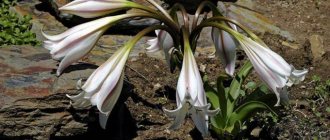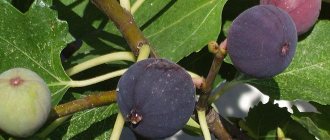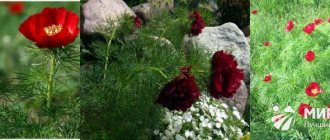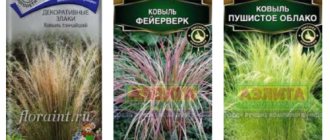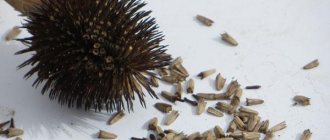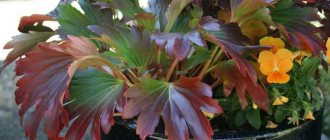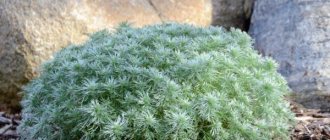Types of rot that affect the plant
There are different types of rot, which have their own symptomatic course and treatment methods.
Root rot
The causative agent is a fungus that spreads to the root system and stem. Damage can be noticeable both on the entire plant and on individual shoots. First, the bush begins to wither, then the leaves dry out without noticeable external changes, the buds turn red and die.
Root rot
If you cut off the shoots, a brown layer is visible. When digging up, brown color and rot are visible on the roots. The plant dies in a matter of days. The flower begins to hurt if the rhododendron was planted in dry soil with an acidic environment. Young plants that have recently been transplanted are susceptible to the disease. The infection spreads through the root and moves to the upper part of the stem.
There are no treatment methods. You need to dig up the bush and burn it to avoid infecting neighboring plants. Subsequently, it is necessary to adjust the acidity of the soil in this place, and for the new seedling the correct watering regime.
Gray rot
The causative agent is the fungus Botrytis ashgray. It lives in uncultivated soil and on the remains of other plants. The concentration of the fungus in the form of mycelium is immediately determined by its appearance.
Note! Infection is favored by high humidity, so gardeners should be wary of damp weather. For the disease to develop, the presence of dead tissue in plants is sufficient, since the fungus is not able to reproduce on living cells. When infection occurs, the fungus releases toxins that spread to and infect nearby living tissue.
The disease includes the following symptoms:
- brown spots on stems, buds, leaves;
- the surface of the damaged area dries and begins to crack;
- sclerotia are formed, which have a round, convex shape.
A distinctive feature of the disease is that the fungal growth is not white, but gray or black. This form of the disease is resistant to negative environmental factors and survives for 2-3 years.
Treatment methods: controlling the pathogen using pruning, preventive spraying of the affected and neighboring plants with a solution of foundationazole.
Gray rot
Late blight rot
The causative agent is the fungus Phytophtora cinamomi. A plant can become sick from neighboring infected flowers. The following conditions contribute to the formation of fungus:
- abundant watering;
- lack or poor drainage;
- increased environmental humidity.
Symptoms of infection and spread of the disease:
- dryness of leaves, which spreads to individual branches;
- lack of restoration of leaf density at night or in the morning;
- the branches become yellow, then the color change is characteristic of the whole plant;
- the roots turn brown and rot forms;
- brown spots in the area of the root collar or the beginning of the stem;
- rot on wood;
- gradually a gray or black spot forms on the brown spots, which is a symptom of the formation of fungal spores;
- later, if left untreated, the entire plant withers and dries out.
Note! If the flower is completely dead, this does not mean that the infection has disappeared. It remains in the soil, so the risk of infection of neighboring crops increases.
Treatment methods: periodically spraying infected plants with Bordeaux mixture, and if the flower is severely affected, it is dug up and burned.
Fluoride rot
Rhododendron bud rot
The plant is infected by the fungus Sporocybe azaleae. The pathogen was first discovered in the United States, and prevention and treatment measures were also studied there. Most often, the disease develops in the largest rhododendron and Katevba. A characteristic feature of the lesion is a change in the shade of the buds to brown or brown. Without treatment, the bush dies.
The pathogen often spreads from the buds to the branches, infecting the entire bush. Saving it is much more difficult; you have to cut out entire meters of shoots.
Treatment methods: every three weeks all parts of the plant are sprayed with preparations containing copper.
Bud rot
Non-infectious chlorosis
This disease, characterized by the appearance of light yellow spots on the leaves of rhododendron, can occur for many reasons - from incorrect agricultural practices to unfavorable soil and climatic conditions (increased soil acidity, deficiency of iron or magnesium in the soil, lack of nitrogen, increased salt content, waterlogging of roots and etc.).
Symptoms : The leaf blade between the conducting veins becomes light green or yellowish-green. In the initial stage of the lesion, the veins still retain a dark green color, later they also turn yellow. With severe chlorosis, all young shoots become yellow or simply pale; they easily get burned in the sun. Constant exposure to unfavorable factors leads to stunted growth and disease, even to the death of the plant.
Control measures : optimization of cultivation conditions - if necessary, liming the soil and/or adding missing elements, etc.
Prevention of occurrence : careful adherence to agricultural cultivation techniques, proper watering, timely fertilizing, normalization of soil acidity.
The main diseases of rhododendron and methods of their treatment
Petunia diseases - why do the leaves turn yellow?
There are various types of infectious diseases.
For your information! Not everyone knows why rhododendron leaves turn brown. To avoid this, you should preventively spray the flower with various preparations, strictly following the instructions for using the insecticide.
There are three main forms of bush diseases:
- fungal diseases of rhododendron. The pathogen spreads through the soil or by wind-borne spores. Damage is noticeable in any part of the plant. Areas of darkening, a rounded formation with a white, gray, or black tint, form. Rhododendron chlorosis is a prime example of a fungal disease;
- infection. This is a lesion caused by various bacteria. The disease can be contained in the soil or carried by insects. Gradually, the pathogenic microorganism spreads along the roots, trunk, leaves, shoots, leading to drying out and death of parts. Usually the pathogen spreads to many parts of the bush. Therefore, it is necessary to burn it completely to avoid the spread of infection to neighboring plants;
- non-infectious causes. There are negative environmental factors that lead to impaired growth, flowering, and also the fact that rhododendron leaves curl. This could be nitrogen starvation, poor-quality soil, or soaking. To preserve the shrub, you should improve the quality of the soil, apply fertilizer and water according to schedule.
In order not to confuse the types of disease, you should familiarize yourself with their symptoms. There is a solution for each type of infection and unfavorable growth.
Tracheomycosis wilt: when leaves curl
Infection occurs from the fungus Fusarium oxysporum. This is a parasite that provokes the following symptoms:
- formation of brown color at the roots, subsequent rot;
- the spread of spores throughout the plant, which blocks the movement of nutrients;
- the leaves lose their elasticity, become sluggish, curl up, and brown spots appear on the rhododendron;
- falling of leaves at the joint petioles;
- A white mycelium forms on the trunks.
Note! If the gardener prunes only the visible infected parts, the spores will remain in the roots and remaining stems. The pathogen will then spread to neighboring healthy flowers.
Treatment methods: burning the entire plant along with the root system, spraying and watering with a solution of foundationazole for preventive purposes.
Dieback of shoots
The disease spreads to rhododendrons that are planted in the shade without the presence of sunlight. A fungus from the genus Phytophtora cactorum Leb spreads throughout the flower. Main symptoms of the disease:
- buds do not bloom;
- gradually the buds and shoots acquire a dark color and die off.
Treatment methods: burning damaged leaves and shoots; after eliminating flowers, spraying with preparations containing copper every two weeks.
Bacterial root cancer
The disease is caused by the bacterium Agrobacterium tumefaciens. It releases plasmids that transform plant cells. Sometimes the pathogen can infect humans, causing symptoms of infection in people with weakened immune systems.
The shrub becomes sick, acquiring the following symptoms:
- the formation of growths on the roots, which become dark and hard, preventing the flow of useful substances into the trunks, shoots and leaves;
- slow growth, weak flowering;
- Gradually, rot forms in the areas of growths.
Important! If the bacterium has not been completely destroyed, it will persist on plant debris and in the soil, causing infection of subsequent plants.
Treatment methods: affected bushes are sprayed with Bordeaux mixture, and if the bush is severely affected, it is dug up and burned.
Diseases caused by pests
There are many types of pests that can cause rhododendron diseases:
- furrowed weevil. Damages leaves - eats large holes in them. If many larvae appear, the entire bush withers and dies. Spraying is carried out with descis, splender;
- spider mite The leaves on which the pest is located turn yellow, change shape, turn brown and dry out. Spraying is carried out using actellik, fufanon;
- acacia false scale. The parasite pierces the bark, attaching itself to the branches. The affected plant does not bloom, gradually dries out and dies. Treatment is carried out with any drug containing phosphorus, for example, fufanon;
- tobacco thrips. Parasites damage the buds, which do not open, turn yellow and fall off. The flower is treated with phosphorus-containing agents, for example, fitoverm;
- New American azalea bug. Because of it, yellow leaves with black spots like resin appear. Rhododendron leaves curl, dry out and fall off. Treatment is carried out by spraying with a soap solution with tobacco.
Note! The parasites usually land on leaves and stems. They are visible to the naked eye. If a large number of insects are observed, treatment should be started immediately.
Furrow weevil
Anthropotic spotting
The disease is caused by the fungus Gloeosporium rhododendri. Areas of red-brown dead tissue appear on the leaves. The leaves dry out quickly and spores of a round shape and dark color form on them. Gradually, the disease moves to the stems, which dry out.
Treatment methods: pruning the affected parts, spraying with Bordeaux mixture.
Nitrogen starvation
This is a disease that occurs when there is a lack of nitrogen and potassium in the soil. The leaf blades become light. Shoots are formed weakly, flowering does not occur. Yellow and then brown spots form on the leaves. Gradually they disappear. To eliminate the disease, nitrogen fertilizing should be applied.
Winter drying
This is not a parasitic disease that resembles shoot dieback. The disease occurs after a harsh winter with severe frosts. When the soil thaws, the leaves curl, lose their elasticity, turn brown and dry out. This indicates a lack of moisture and damage to internal parts from severe frosts. When the flow of water through the inside is normalized, the rhododendron will return to normal.
Note! It is necessary to water abundantly and spray up to several times a day.
Leaf swelling (thickness)
Otherwise the condition is called wax disease. It is caused by Exobasium fungi. Characteristic symptoms are observed:
- deformation and thickening of leaves;
- the leaf blade begins to turn red;
- the formation of a waxy coating consisting of spores;
- damaged areas dry out and crack;
- flowering is absent or weak.
Treatment methods: trimming damaged parts, spraying with Bordeaux mixture.
Sunburn
This occurs when the temperature fluctuates sharply. The foliage heats up and evaporates moisture. It becomes brown, dry, and spots appear. For prevention, it is recommended to plant the shrub in a dark place. If this is not possible, you should make a shelter over the bush from the scorching sun.
Sunburn
Cercospora
If a rhododendron has brown leaves, not every gardener knows what to do. The disease is caused by the fungus Cercospora rhododendri Ferraris. It causes rhododendon leaves to appear brown, and if there is additionally high humidity in the area, they become covered with a coating containing spores. Treatment is carried out using fungicidal agents.
Cercospora
Locking
If little oxygen reaches the root system of the shrub, the leaf blades become dull and green. The shrub drops its leaves for no apparent reason. The emerging shoots are soft. The root ball quickly collapses.
Often the disease forms where the soil is rotten, heavy, and has poor drainage. Treatment requires a water- and breathable substrate and drainage. Watering is limited.
Factors that lead to diseases
Professionals unanimously claim that the problems that arise in the process of growing beautiful flowering shrubs are associated with violations of agricultural technology.
Unfavorable factors are:
- Low acidity of the soil, which leads to depletion of the plant.
- Increased soil moisture and stagnation of water at the roots.
- Planting a bush in an area where sunlight burns delicate foliage.
- The use of inappropriate nutritional compositions and violation of fertilizer dosages.
- Dry soil, particularly in winter.
- Sudden changes in temperature, refusal to cover roots in winter.
- Poor or depleted soil.
- Poorly selected soil composition, on which the plant simply gets wet.
In order to grow a healthy rhododendron, and not subsequently study diseases and pests from photos, you should strictly adhere to the rules of agricultural technology of the variety. By following simple tips, you can enjoy the abundant flowering of rhododendrons for many years in a row.
Prevention and plant protection
Marigold diseases - why leaves dry out
In summer and spring, plants should be periodically sprayed with insecticides and fungicides. The soil should be moderately moist; plants do not like large amounts of water, but also do not grow in dry places. The soil must have good drainage for growth and flowering to occur.
Note! Most often, rhododendron suffers from a fungal infection. Gardeners prefer to spray the bushes with Bordeaux mixture, which destroys most types of mushrooms.
Rhododendron is often susceptible to diseases, the treatment of which depends on their cause. It can become infected with a bacterial or fungal infection. But the gardener must also take into account that a flower requires certain conditions in order for it to grow and bloom successfully. If the leaves of a rhododendron wither, this article will tell you what to do if you re-read it carefully. And it is advisable not to delay treatment, so as not to lose the entire bush overnight.
Reasons for lack of flowering
Below are 7 main reasons why rhododendrons do not bloom in open ground.
Soil too alkaline
Rhododendrons thrive in acidic, permeable soils. Alkaline soil pH is a common reason why a bush does not bloom and looks bad. The optimal pH is 4.5-5.5. Low pH levels ensure proper absorption of nutrients by the plant.
You can get the desired acidity level by adding:
- acidic horticultural peat;
- composted pine bark;
- preparations for acidifying the substrate.
It is necessary to make the soil acidic when planting and mulch with pine bark.
Too little sun
A semi-shaded position is recommended for rhododendron; it does not bloom in full shade, and in the sun the leaves are susceptible to sunburn. Unfortunately, gardeners often plant rhododendrons in areas that are too shaded. Therefore, when the bush is not blooming, you need to make sure that the position is partially shaded. You can plant the bush under taller trees - pine, fir, whose root system will not compete with the roots of rhododendrons.
There are exceptions to this rule. The following large-flowered varieties grow well in full sun:
- "Katharina von Toll"
- "Cunnigam White"
- "Torero."
Small varieties grow well in full sun. For them, greater insolation promotes better flowering and does not harm the leaves.
Bad fertilizer
Moderation should be maintained when fertilizing. Too generous doses of fertilizing can adversely affect the plant. Limit fertilizer to 2 doses:
- the first - at the beginning of the growing season stimulates flowering;
- the second - in the summer, will allow you to properly tie the buds for the next season.
If you fertilize frequently with nitrogen, it will cause abundant leaf growth and lush development, but flower buds will not set. It is necessary to apply superphosphate, which stimulates flowering.
Inflorescences are not removed
To ensure that rhododendron blooms well, it is important to remove faded inflorescences, preventing the formation of seeds. Then the bush will continue to bloom.
Attention! Inflorescences should be broken off rather than trimmed with scissors. In this way we imitate the natural process of the inflorescence falling. The task is quite tedious, but the consequences reward the effort.
Freezing of kidneys in winter
The plant sets flower buds in the summer, they bloom in the spring of the following year. When the winter is cold and windy, the buds can freeze. The planting site must be chosen semi-shaded, secluded, protected from freezing and dry winds (such winds prevail on the eastern side). In winter, it is necessary to cover with agrotextiles or pine branches. When the leaves become drooping in winter - this is a sign of lack of water, it is worth watering the plants during the thaw.
Fungal diseases
Often rhododendron does not bloom as a result of disease. Gray mold appears as brown spots that dry out and form a grayish, dusty coating on the surface.
Causes of gray mold:
- infection is favored by high humidity;
- temperature above 15°C.
To prevent the appearance of gray mold, avoid excessive compaction of plants and cut out infected shoots.
Another fungal disease is bud death. Shrunken flower buds appear, the leaves darken, and the rhododendron does not bloom. Infected buds should be removed.
Aphid
Aphid colonies appear on young shoots in the spring, the shoots weaken, and the rhododendron does not bloom. Heavily infected bushes die. Aphids carry many viral diseases. Control is carried out by spraying with insecticides Mospilan 20 SP, Karate Zeon 050 CS, Fastac 100 EC.
Varieties of spotting
There are also several types in this section. The most common are the following:
Pestalociaceae
The disease affects the stem part and leaf plates of the flower. Dark brown spots of irregular shape appear on them. They are framed by a thin brown edging.
There are more spots on the shoots than on the leaves. The spore pads are usually located on the spotted, infected part of the leaf.
Diseased areas are carefully cut off and the bush is treated with Bordeaux mixture or Camulus.
Anthracnose spot
Brownish areas appear on the upper parts of the leaves. The leaves then dry out. Dark spots then grow onto the stem part. The affected leaves and shoots are cut off, and the bush is sprayed with Bordeaux mixture.
In addition, the following types of spotting of rhododendrons are distinguished:
Homemade iron chelate
It’s easy to make iron chelate with your own hands at home using two traditional methods:
- Dilute 10 g of iron sulfate (not to be confused with copper sulfate) in 1 liter of water. Add 20 g of ascorbic acid. Spray and water chlorotic plants with this solution.
- Dilute half a teaspoon of citric acid in one liter of water. Add 2.5 g of iron sulfate. The result is a light orange liquid containing a complex salt of ferrous iron. This solution is used for spraying and watering plants.
The shelf life of homemade iron chelate is 2 weeks.
One of the unconventional and very common methods of combating chlorosis at home is to bury rusty nails in a pot with a plant. The main thing here is the presence of rust.
It is always better to act proactively to prevent the disease with timely feeding and quality care.
I take iron chelate in ampoules, liquid and dilute it in a 0.5-liter bottle, pour it into a spray bottle and treat the plants when there is no sun. Works quite effectively
I added vermiculite to the soil with microelements that kill chlorosis. In this case, the plant does not need to be replanted; it is enough to remove the top layer of soil and add soil with vermiculite. Ferovit, containing iron, is fed to the plant at the root. I personally used ferovit and was very pleased with the result.
I can tell you from my own experience how I treated passionflower. After applying a complex of fertilizers with a high nitrogen content, I noticed that the leaves on the plant began to curl. I poured a complex solution containing: manganese -4.2%, iron -8.14%; copper -0.5%; boron -1.6%, zinc -1.0%, cobalt -0.2%, molybdenum -0 ,1%. Improvements were noticeable within a day. The chlorotic spots on the leaves have practically disappeared and they have unfurled.
I only have a few evergreen rhododendrons growing in my flowerbed. Recently the leaves have started turning yellow for no apparent reason. It so happens that their place is the sunniest, there is almost never any shade.
I recently learned that it turns out that it is these plants that grow in the sun that are most susceptible to disease.
To save my rhododendrons, I had to study quite a lot of information about the main mistakes gardeners make, diseases and infections, as well as methods for treating them. I am happy to share with you, and also attach photos and videos. After all, no one wants to lose such a flower garden decoration, right?
Diseases caused by pests
Among this group of diseases, the most intolerable for rhododendrons is the rhododendron bug. Symptoms of infection are the formation of viscous white traces. Small marks usually appear on the leaves. The bug is destroyed by spraying with diazinon.
The acacia false scale is a small insect. They are brown in appearance and oval in shape. The larvae make a hole in the bark with their proboscis, after which they begin to receive nutrients from the stem. After infection, the plant begins to wither - it weakens, loses its former beauty, and after some time dries out. If the rhododendron begins to dry out quickly, it is necessary to treat it once a week with a special product containing organophosphorus substances.
Spider mites are very small insects, and without optical devices it is impossible to see them.
As a rule, the mite infects rhododendrons in hot and dry weather by eating the leaves of the plant. The pathogen is identified symptomatically by external signs - a thin cobweb appears on the underside of the leaves, and the leaf itself becomes brown in color, becomes dull, and possibly falls off. To combat the parasite, it is necessary to use agravertine or diazinon.
Tilled slug. It parasitizes the crown and leaves of young plants. The pest bites into the thickness of the crown, leaving behind significant holes. A slug can destroy a plant very quickly. In order to prevent the plant from being destroyed, the arable slug can be collected manually, or treated with a 0.8% TMTD solution.
The Asian beetleworm is a pest that can cause the most damage to rhododendrons. When infected, the stems and root system are damaged. The leaf is also used as food for the beetleworm. The most effective means of control is diazinon.
The grooved weevil is a small insect with a dark black color. It can cause significant damage to an ornamental plant, and if healing measures are not taken, it can even destroy it. The bug eats foliage, flowers, buds, and in some cases bark. It is especially active in the summer, so at this time it is recommended to treat the plant and soil with bazudin or furadan.
Narrow-winged moth. The larvae (caterpillars) of this moth leave behind a large number of holes, eating through the foliage, after which they “wrap themselves” in a leaf in order to pupate. After some time, the foliage deteriorates - it dries out, crumbles, and falls off. It is recommended to fumigate or treat the bushes with sulfur so that the moths get rid of the smell - thereby preventing the deposition of larvae.
Gastropods. They belong to the genus Helix. Represented by various types of snails and slugs. Capable of destroying different parts of plants - buds, leaves, shoots. These representatives are usually controlled by hand collection, or a variety of molluscicides can be used.
Rhododendron fly - damages the leaves of bush rhododendrons, leaving behind small, light-colored spots. It is a specific pest, that is, one that is unique to this type of plant. In order to eliminate flies, nicotine sulfate should be used by spraying it on the plant.

